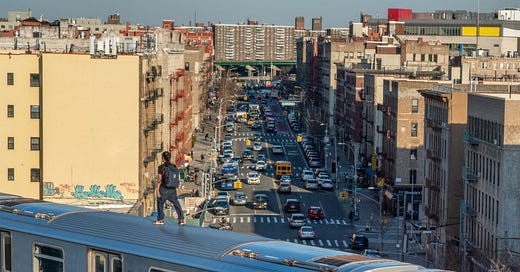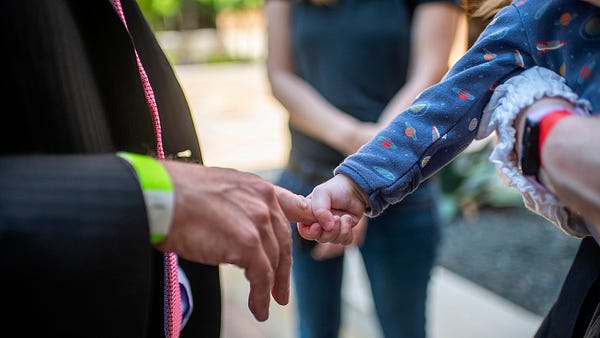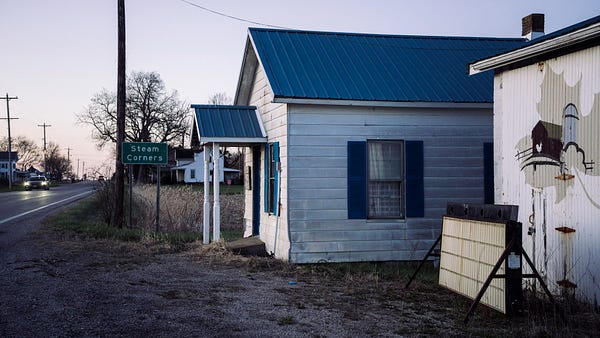
The Free Press

In early August, a riot broke out in New York City’s Union Square: thousands of kids, mostly from the outer boroughs, threw smoke bombs, lit fireworks, broke windows, stomped on cars, and climbed street poles. They were in full break-shit mode.
When I saw it happening on my iPhone, their age struck me. Pubescent, with smooth faces, maybe a splash of acne, riding the massive testosterone high that is adolescence through the humid late-summer doldrums.
The powder keg of a hot New York City is rife with this sort of stuff—young people hungry to fight, make some noise, prove their cojones or courage or whatever. It’s just a question of who or what is going to set it off.
In this case, it was Kai Carlo Cenat, the 21-year-old Twitch streamer-slash-YouTuber pledging to give away PlayStation 5s to anyone who showed up at the square. By 3 p.m., an hour before the giveaway was scheduled to start, it was teeming with loud, sweaty, excitable kids, and soon, the chaos gave way to pockets of violence—shoving, fighting, overturning police barricades, destroying other people’s property, disorder engulfing order.
Cenat was ultimately charged with inciting a riot, and police arrested 65 people—30 of whom were under 18.
The respectable classes—the people, mostly white, who have money and live uptown or in the suburbs—tut-tutted about the whole thing on X, formerly Twitter, or Instagram, or wherever respectable people tut-tut about things now. They objected to the broken glass, the umbrellas of the hot dog stands that had been smashed or pummeled. The mess.
That’s reasonable enough, but it’s not the real issue.
The real issue is harder to make out, and more insidious. It’s the breakdown of tribe and community, which has been happening in slow motion for several decades, as the old social fabric has steadily eroded.
But maybe we can see the value in these young men. To stop regarding them as expendable. And meet them where they live.
The young men of Union Square have a lot in common with the young men who ride the rooftops of the subway cars that bisect my Queens neighborhood.
I live in Sunnyside, a sleepy little warren filled with families, strollers, immigrants from Ireland and Mexico and Turkey and pretty much everywhere else. By New York standards, there’s not a lot of crime.
The No. 7 train runs through the center of the neighborhood on an elevated platform. In the late afternoon and early evening, the sun ducks behind the skyscrapers in Manhattan to the east, and the whole neighborhood is painted a golden-reddish hue.
That’s when the platform becomes a field on which boys like to prove their mettle. As the subway passes above ground, they clamber up the doors between the cars onto the top of the train. They take in the view, walk up and down the stainless steel rooftops, take a selfie, get some video they can post to their social media feeds. They’re usually between 13 and 16, and they’re almost always black and Latino. Sometimes, they die.
I imagine the wind whistling past them. Their legs shaking. A tunnel approaching. The ballsiest of them lying flat with their backs against the roof as the ceiling of the tunnel, inches away, races past the tips of their noses.
Kids have been doing stupid, jackass things like this forever, but the numbers are going up.
Between 2021 to 2022, the number of subway surfers jumped 366 percent.
In June, two 14-year-old boys collided with the entrance of a tunnel as the train they were surfing dipped underground. One of them, Briyan Crespo, died. The other, Widinson Garcia, may never walk again. One of the boys was hit so hard, his shoes were knocked off.
A month later, 14-year-old Jevon Fraser died while riding the No. 7 train that goes past my apartment. He apparently fell off the roof.
The subway surfers, like the rioters who broke car windows and made a mess of Union Square, are largely drawn from the same cohort of directionless and bored young men. They are scared and unformed and often without male role models, and they are constantly prodded into doing, thinking, and saying idiotic things by the mobs of other young men. Everyone egging everyone else on, no one old enough or wise enough to state the obvious: this is not how you become a man.
Once upon a time, these boys would have been absorbed by other things: a boxing gym; a basketball court; a church; a job; a classroom; their apartments overflowing with siblings, cousins, friends, their mother in a cramped kitchen making dinner. Young men in search of themselves had a degree of freedom to try out different groups or tribes or personalities within the relatively safe confines of their community. It was hardly free of violence or danger. But there was a way things were done. There were guardrails.
Those who don’t grow up like these young men have no idea what it’s like to live in a world stripped of its guardrails. Their lives are structured, organized. There are guardrails everywhere—rules and regulations meant to protect their children from the vagaries of city life. Or just life.
They send their kids to climbing gyms or Muay Thai classes, or maybe they kayak the Colorado River or a Norwegian fjord, or ski some uncharted mountain. The violence or quasi-violence they take part in is a compartmentalized and sanctioned violence. We call it sport, and they will probably mention that sport on their college applications.
Let’s be clear: wealthy young men have the same need to demonstrate their manliness, but the society from which they come insists that they do so in a way that is relatively safe and edifying and even marketable. They are doing the same thing the young men of Union Square and the No. 7 train are doing. They are proving their worth, but at a vastly reduced cost.

I know something about the young, dumb men prowling the streets of New York because I used to be one. I had a MetroCard and a desire to fuck shit up, and I am lucky I never had the chance to do anything dumber than scrawl my name on the facade of a local RadioShack.
Many of my friends were not so lucky. I see their faces in the pictures of the rioters, the subway surfers—all of them young men trying to define themselves in a world that has made it harder than ever to do just that.
I’m in my early thirties, and the way boys in the city showed our courage fifteen or twenty years ago was by tagging. Graffiti.
A lot has been made of the artistic qualities of graffiti, but we weren’t in it for that. It was all about climbing somewhere dangerous to do something you shouldn’t do. Defying order. Proving we were tough and strong and worthy of a desirable mate.
Armed with paint pens and cans of spray paint, young men ran wild across the city in the nighttime hours, scrawling their pseudonyms (“Funky Fresh,” “Knave,” “Breezy”) across buildings and signs and walls, down in the tunnels, up on the rooftops of buildings. The truly brave sneaked into buildings and scaled the billboards on top of them so drivers on the Brooklyn-Queens Expressway could see their tags. I never made it off the sidewalk.
A boy who scrawled his name somewhere really spectacular could become the subject of local legend. His classmates would point out a tag at the top of a building that seemed impossible to scale. “That was Chris,” they’d murmur, as you scratched your head wondering how the hell Chris managed to get up there. We just wanted adventure, camaraderie, maybe a little glory.
But boys—men—constantly push boundaries. If we don’t, then what’s the point? It’s really dangerous only if it’s never been done before—if no one can be sure you’ll get out of this okay.
So, for other boys, tagging was never going to be enough. Nor was shoplifting. Nor was shooting heroin (think The Basketball Diaries). Nor was having unprotected sex (à la Kids).
You have to keep pushing. Doing dumber and dumber and more destructive and dangerous stuff. Like TikToking on the roof of a subway car going 55 over the Williamsburg Bridge.
The pushing is never going to stop, and officials wagging their fingers won’t do much good. That’s just grown-ups telling young people not to be stupid. It’s not telling them how not to be stupid—how to be grown-ups themselves. It’s not giving them a boxing gym, or church, or army, or cause, or sense of purpose.
A lot of people are going to ask why we should indulge these boys’ desire to show physical courage.
But along with being a reformed knucklehead, I’m a big fan of history, and here’s what I know. The stupid courage of young men—to ride on top of the subway or go toe-to-toe with the NYPD at Union Square—has historically been a virtue. The same idiots causing your train delay are descended from men who faced down saber-toothed tigers when we lived in caves. At Flanders, they were the ones to go over the trench when the whistle blew.
We like to think we are past the need for dumb physical courage, but when I go on YouTube and watch the endless streams of frontline combat videos taken by young men fighting the Russian invasion in Ukraine, it hits me how young their voices sound. No matter how far the No. 7 train seems from the Ukrainian battlefields I see on my screen, no society sails in peaceful waters forever. One day we may need to break the glass on our knucklehead boys again.
The crisis we face is not really about children being dumb. In fact, it’s not really about children. It’s about adults not knowing how to be adults. Not knowing, or forgetting, how to steer our angry young men out of the pitfalls of adolescence and toward something better.
McCaffrey Blauner is a writer living in New York City. His writing has appeared in The Nation and The Daily Beast. This is his first piece for The Free Press. A version of this essay first appeared on his Substack; follow him on Twitter here.
And to support our mission of independent journalism, become a Free Press subscriber today:
Also: We’re hosting our first live debate on September 13 at the Ace Theatre in Los Angeles! Has the sexual revolution failed? Come argue about it and have a drink. We can’t wait to meet you in person. You can purchase tickets now at thefp.com/debates.















The last paragraph of this piece is gold.
This is a beautiful piece of understanding and empathy. I hope to see a lot more from McCaffrey Blauner at the FP.